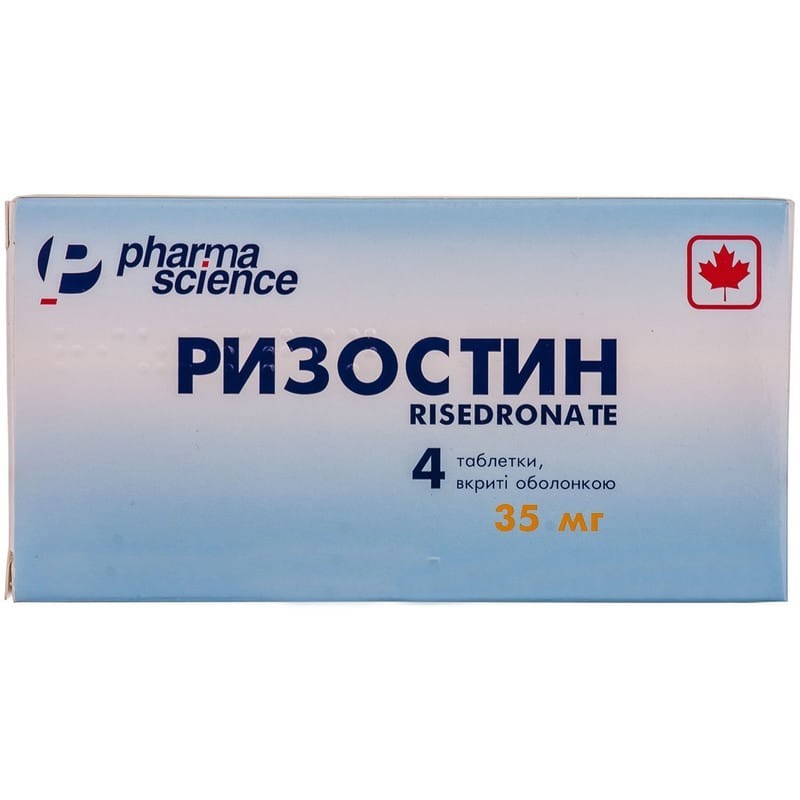



 Secure and encrypted payment processing
Secure and encrypted payment processing We ship to over 40 countries including the USA, UK, Europe, Australia and Japan
We ship to over 40 countries including the USA, UK, Europe, Australia and Japan Guaranteed refund or reship if you haven't received your order
Guaranteed refund or reship if you haven't received your orderRizostin tablets are used for the following indications:
The active substance is sodium risedronate (one tablet contains 35 mg of sodium risedronate in the form of sodium risedronate hemi-pentahydrate).
Excipients: anhydrous colloidal silicon dioxide, maltodextrin, mannitol (E 421), povidone, pregelatinized starch, sodium starch glycolate (type A), sodium stearyl fumarate, anhydrous ethanol.
Tablet shell: sucrose, triethyl citrate, titanium dioxide (E 171), yellow iron oxide (E172), red iron oxide (E172), talc, anhydrous ethanol, polyvinyl alcohol - polyethylene glycol grafted copolymer.
The recommended dose is 35 mg once a week, orally.
To achieve a certain effect, it is necessary to strictly follow the instructions for taking the drug. The drug should be taken on an empty stomach, at least 30 minutes before meals, drinks (except ordinary water) or other medicines. The tablet should be taken standing, swallowed whole, without chewing, and washed down with a sufficient amount of water (at least 120 ml) so that it gets into the stomach.
For at least 30 minutes after taking the pill, the patient should be in an upright position.
If the dose is missed, the pill should be taken on the day when it was remembered. Next, the patient should take one tablet per week on the day that he / she usually takes the tablets. You can not take two tablets on the same day.
It is necessary to consider the feasibility of additional intake of calcium and vitamin D, if the intake of these substances with food is insufficient.
The potential risk to humans is unknown. Sodium risedronate should not be used during pregnancy and lactation.
Since data on the safety and efficacy of sodium risendronate in children (under the age of 18 years) are insufficient, the drug is not used for these patients.
No effect on the ability to drive vehicles or other mechanisms has been identified, but it must be borne in mind that while taking the drug, side reactions from the organs of vision are possible, which may be accompanied by a deterioration in visual acuity and photophobia.
Information on any specific treatment for acute overdose of sodium risedronate is not yet available.
With a significant overdose, a decrease in serum calcium and the development of symptoms of hypocalcemia are possible.
It is necessary to give the patient milk or antacids containing magnesium, calcium or aluminum to bind sodium risedronate and reduce its absorption.
In case of a significant overdose (if it took no more than 30 minutes after taking the drug), gastric lavage can be recommended. You can also use conventional means to relieve symptoms of hypocalcemia, including the introduction of calcium preparations.
Most adverse reactions during clinical trials were mild or moderate and did not require discontinuation of the drug.
From the nervous system: headache.
From the gastrointestinal tract: dyspepsia, nausea, constipation, diarrhea, abdominal pain, duodenitis, esophagitis, gastritis, dysphagia, esophageal ulcers, glossitis, esophageal stricture.
From the musculoskeletal system and connective tissue: pain in the muscles, joints and bones.
Laboratory results: rarely - changes in liver function indicators.
Some patients experienced an early temporary asymptomatic mild decrease in serum calcium and phosphate levels.
From the side of the organs of vision: inflammation of the iris, uveitis, conjunctivitis, episiscleritis, iritis, scleritis.
From the side of the musculoskeletal system and connective tissue: atypical subrochanteric and diaphyseal fractures of the femur, osteonecrosis of the lower jaw.
On the part of the skin and subcutaneous tissue: hypersensitivity reactions and skin reactions, including angioedema, generalized rash, urticaria, as well as bullous skin reactions and leukocytoclastic vasculitis (severe reactions were sometimes observed, including isolated cases of Stevens-Johnson syndrome and toxic epidermal necrolysis) ; hair loss.
From the immune system: anaphylactic reactions.
Hepatobiliary disorders: serious liver disorders. In most recorded cases, patients also received treatment with other drugs with a known ability to cause liver disorders.
Very rare: osteonecrosis of the external auditory canal (an undesirable reaction of the class of bisphosphonates).
Store at a temperature not exceeding 30 ° C, out of the reach of children.
Shelf life is 5 years.